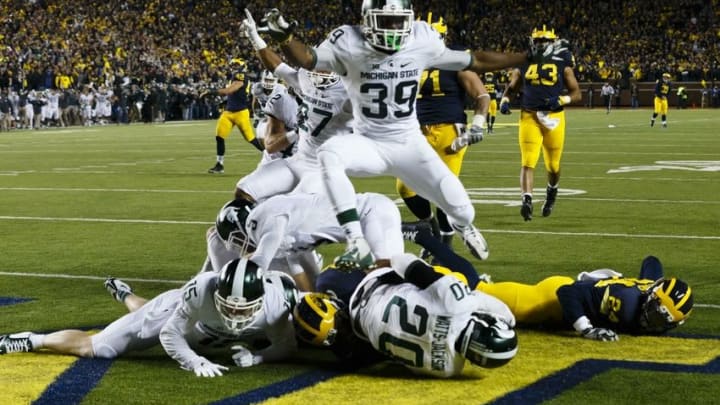“Artest has jumped over the scorer’s table… Artest is in the stands!”
A fight between players is one thing, but when a brawl breaks what Jonathan Abrams called “the invisible wall that separates athletes and spectators… the social contract of arena behavior is left in shreds.”
The Detroit Pistons came into the 2004 season as reigning NBA champions, having knocked off the star-studded Los Angeles Lakers in the Finals. On their way to that title, the Pistons had defeated the Indiana Pacers in the conference finals.
The two teams met for the first time in 2004 on November 19 at the Palace of Auburn Hills. The game was a national broadcast on ESPN. Indiana quickly opened up a double-digit lead and held on to it for most of the game.
With less than a minute to go, having led for pretty much the entire game, the Pacers held a comfortable 97-82 lead. There had been a couple of incidents of chippy play, particularly between Detroit’s Ben Wallace and Indiana’s Ron Artest, but nothing too out of the ordinary for a series between physical division opponents.
More from Detroit Jock City
- Tigers Sign Manager A.J. Hinch to Long-Term Extension
- Lions vs. Bears Week 14 Opening Odds Disrespect Detroit
- Former Tigers Celebrate Jim Leyland Hall of Fame Call
- This Pistons Team Could be the Worst in Detroit Sports History
- 4 Free Agents Tigers Should Sign During Winter Meetings
With about 46 seconds left, Wallace was fouled by Artest on a layup. He expressed his disapproval by shoving Artest in the chest after the play. Officials and teammates quickly moved to keep the two players separated.
While Wallace was being calmed down, Artest made the odd decision to lay down on the scorer’s table by the bench. While Wallace, who was still upset, threw an armband at him, Artest grabbed a headset from the Pacers’ play-by-play unit and put it on, a gesture Indianapolis Star writer Mark Montieth suggested was Artest “clowning around… saying ‘I’m trying to be good.'”
A Detroit fan in the stands named John Green decided this was an opportunity and lobbed a cup filled with liquid at Artest, hitting him in the face as he lay on the table. Artest sprang to his feet and bolted into the crowd, trampling Pacers’ play-by-play announcer Mark Boyle, who suffered five fractured vertebrae.
Pacers guard Steven Jackson joined his teammate in the stands as Artest ran toward the area from where the cup had been tossed and proceeded to attack a fan, Michael Ryan, who Artest thought had thrown the cup. While Green tried to fight Artest as Artest tangled with Ryan, another cup of liquid was thrown, hitting Steven Jackson, who by then was right where the fracas was taking place. Jackson responded by punching the thrower, a fan named William Paulson, in the face.
Several fans and Pacers’ players, as well as the Pistons’ Wallace, were involved by this point, trying to separate teammates from fans. Artest punched another fan, A.J. Shackleford, who confronted him after he had returned to the court. Shackleford’s friend Charlie Haddad came to Shackleford’s defense and shoved Artest, but was punched in the head by Indiana’s Jermaine O’Neal.
As the Pacers’ players were led by team officials into the tunnel after the game was called, Pistons fans rained down food and drinks and other items, including a chair, at the players and team personnel leaving the court.
After the game, Wallace, who was playing in his first game back after the death of his brother the week before, said that “(Artest) told me he was going to hit me, and he did it. That was just one of those things. It happened in the heat of the battle.”
Five Pacers were charged for their roles in the brawl and each received one year of probation, a $250 fine, community service hours and anger management counseling.
Auburn Hills Police Chief Doreen E. Olko said, “We have zillions of security plans for the Palace, for all kinds of things. But none included a player going up in the stands. That just is not something anybody foresaw.”
Rick Carlisle described the situation tersely. “I felt like I was fighting for my life out there,” he said.
The next day, Artest, Jackson, O’Neal and Wallace were suspended indefinitely. Artest was eventually suspended for the entire season without pay, while Jackson, O’Neal and Wallace were suspended 30, 15 and six games respectively.
Five Pacers were charged for their roles in the brawl and each received one year of probation, a $250 fine, community service hours and anger management counseling. Several other players on both teams were suspended for one game by the NBA. Five fans, including Green, were charged in some manner. Green was sentenced to 30 days in jail and two years of probation for his role and was banned from attending future Pistons’ home games.
Backlash surrounding the game was immediate, and much of the vitriol was directed at the fans. Some perceived the game as a realization of the NBA’s oft-stereotyped “thug” image. In the aftermath, radio commentator Rush Limbaugh famously referred to the NBA as the “Thug Basketball Association.” The league implemented a dress code for players the next season, which was seen by some as an attempt to clean up the perception of the league, while other saw it as a racist attack on urban, and specifically African-American, culture.
The NBA changed security rules for its arenas soon afterward, adding security between fans and the court and limiting alcohol sales.
The Pistons went on to defeat the Pacers, who had only a moderately successful season after the suspensions, in the playoffs before losing to the San Antonio Spurs in the NBA Finals in seven games.
